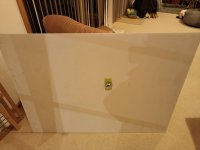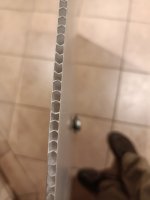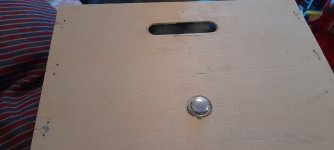SteveEucy.
Any chance of a couple of pictures of the flutes and panel.
Steve.
Pics attached..I think the v shapes in the flutes at the end are from the cutting of the sheet.. It's still stiff despite the kinks
This is the 24w exciter
Cheers
Eucy
Attachments
Last edited:
SteveThis dome is very thin and light, it will be interesting how it sounds and measures .
I will glue the second dome to an exciter coil foot ,without the panel .
I only used the 50x50 pva mix , but it still feels quite hard and solid.
I thought it might be a bit softer.
Like a fabric dome.
I may have to go back to the thin cotton sheeting.
Steve.
Are you concerned about resonance in the stiff dome?
Eucy
While we're on the subject of domes, In the interest of public good, I have decided to reveal my top secret weapon in the quest for extended hf performance in panels 😱🤭😜
As has been noted by myself and others over time, there's often/sometimes a loss of treble when an exciter is stuck to the back of a solid panel. Sometimes it feels as though the sound is coming from the back of the panel. It happened with my cedar panels and also with the ply and most recently the poly.
To overcome this shortfall, I have come up with a simple and effective method...
Enter the EucyDome!!! Lol ...drumroll😂
I feel that I should spin this out a bit ... Like episodes of a soap opera just for fun ..
So to start..Episode 1:
You'll need to have one of these (or equal)
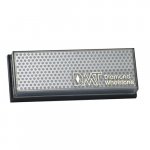
That's a sharpening block..
Eucy
As has been noted by myself and others over time, there's often/sometimes a loss of treble when an exciter is stuck to the back of a solid panel. Sometimes it feels as though the sound is coming from the back of the panel. It happened with my cedar panels and also with the ply and most recently the poly.
To overcome this shortfall, I have come up with a simple and effective method...
Enter the EucyDome!!! Lol ...drumroll😂
I feel that I should spin this out a bit ... Like episodes of a soap opera just for fun ..
So to start..Episode 1:
You'll need to have one of these (or equal)

That's a sharpening block..
Eucy
Eucy.Steve
The flutes are square.
I believe it's important for the exciter to have as direct a contact with the front radiating surface as possible. There's a paper somewhere which examines the loss of hf through distortion in the voice coil former by compressive forces, and I think the same is happening in the thin ribs of these sheets in the coil area.
If it was possible to inject expanding foam locally it would work I think.. Have to think on it. Cutting a hole will damage the flexural properties I think, particularly given the ribbed structure and polypropylene's bonding properties
As for the hump, I ran my ear along the open flutes and yes, there's a distinct increase in volume at the end of the flutes along the line of the exciter. Stands to reason.. They're acting like an acoustic tube. Maybe it favours certain frequencies depending on the tube length (distance from the exciter to the edges). I taped up a section and it seemed to decrease it
Dome..So how do you form the dome from tea bag material?
Eucy
The measurements I made of the proplex panel does not show any signs of any nasty peaks from the central area, so it is well controlled.
I have only tried domes on thin materials , except for thinned eps.
3mm ply should be OK.
I think the high frequencies are probably travelling along the flute struts as this makes the panel more rigid along the flutes , and why the frequencies are stronger on the struts that have the exciter on.
This type of panel is used for poster's and signage, so what inks
do they use ?
Steve.
SteveEucy.
The measurements I made of the proplex panel does not show any signs of any nasty peaks from the central area, so it is well controlled.
I have only tried domes on thin materials , except for thinned eps.
3mm ply should be OK.
I think the high frequencies are probably travelling along the flute struts as this makes the panel more rigid along the flutes , and why the frequencies are stronger on the struts that have the exciter on.
This type of panel is used for poster's and signage, so what inks
do they use ?
Steve.
They print on self adhesive vinyl and simply stick it to the poly flute board
Eucy
I'm not sure about the resonance of the stiff dome, although I think hard domes do have a hard sound ?Steve
Are you concerned about resonance in the stiff dome?
Eucy
It's more to do with the reflections within the voice coil cavity area, causing resonances.
My concave dome eggshell tweeter looked great, but it increases the noise and raised the frequency because of the reduced cavity area.
Making the material softer like a fabric dome seems to reduced this resonance and maybe let's this area breath a little?
It certainly reduces the harshness in sound from this area.
Steve.
Ok .. So have you tried not cutting a hole and still attaching your fabric dome ?I'm not sure about the resonance of the stiff dome, although I think hard domes do have a hard sound ?
It's more to do with the reflections within the voice coil cavity area, causing resonances.
My concave dome eggshell tweeter looked great, but it increases the noise and raised the frequency because of the reduced cavity area.
Making the material softer like a fabric dome seems to reduced this resonance and maybe let's this area breath a little?
It certainly reduces the harshness in sound from this area.
Steve.
Eucy
Eucy.
This is one of my crate ply panels with a centre voice coil cover off of a small cone driver, I stuck it on with bluetack, for quickness.
I have stuck various cone materials on different panels.
But have come to no serious conclusions.
Steve.
This is one of my crate ply panels with a centre voice coil cover off of a small cone driver, I stuck it on with bluetack, for quickness.
I have stuck various cone materials on different panels.
But have come to no serious conclusions.
Steve.
Attachments
Hi Eucy,Hi Christian
Are you sure you bought polypropylene and not polycarbonate?...Although you can get a clear grade, Polypropylene is usually a milky white or coloured
The transparent stuff is commonly the carbonate variety... Considerably glassier and stiffer than the propylene. Worth checking ..Thought I'd ask anyway
I have the Loctite primer in my workshop and have used it with super glue on poly previously but not on a vibrating panel.
I think the styrene based glue I have will probably work on a prepared surface. A good quality PVA glue may also be ok
I also have in mind a product which is sold as a sealant but which I have found to be an excellent special purpose adhesive
Here it's called 'All Clear' and is sold by Selleys. It's very sticky, can be scraped thinly and sticks tenaciously to just about anything
https://www.selleys.com.au/products/sealants/selleys-all-clear/
Cheers
Eucy
Good question... I checked and... unfortunately for me you are right, it is polycarbonate. I thought have read PP on a label but no and double checking with the material name "Carboglass" which confirms polycarbonate. The weight is about 700g/m². Similar material was already mentioned in previous post. As i have it, I will probably make a test one day.
I am a bit surprised by the stiffness evaluation I read. This plate is not in my opinion so stiff and it gives an impression of damping.
Thank you for the information about the glues. If the Loctite product seems the same, I haven't found some equivalent to your styrene based glue. Difficult to understand what is a product behind the marketing name.
Christian
Aha....👍Eucy.
This is one of my crate ply panels with a centre voice coil cover off of a small cone driver, I stuck it on with bluetack, for quickness.
I have stuck various cone materials on different panels.
But have come to no serious conclusions.
Steve.
Eucy
Curious what comes next!While we're on the subject of domes, In the interest of public good, I have decided to reveal my top secret weapon in the quest for extended hf performance in panels 😱🤭😜
As has been noted by myself and others over time, there's often/sometimes a loss of treble when an exciter is stuck to the back of a solid panel. Sometimes it feels as though the sound is coming from the back of the panel. It happened with my cedar panels and also with the ply and most recently the poly.
To overcome this shortfall, I have come up with a simple and effective method...
Enter the EucyDome!!! Lol ...drumroll😂
I feel that I should spin this out a bit ... Like episodes of a soap opera just for fun ..
So to start..Episode 1:
You'll need to have one of these (or equal)
View attachment 1084502
That's a sharpening block..
Eucy
Christian
Hi ChristianHi Eucy,
Good question... I checked and... unfortunately for me you are right, it is polycarbonate. I thought have read PP on a label but no and double checking with the material name "Carboglass" which confirms polycarbonate. The weight is about 700g/m². Similar material was already mentioned in previous post. As i have it, I will probably make a test one day.
I am a bit surprised by the stiffness evaluation I read. This plate is not in my opinion so stiff and it gives an impression of damping.
Thank you for the information about the glues. If the Loctite product seems the same, I haven't found some equivalent to your styrene based glue. Difficult to understand what is a product behind the marketing name.
Christian
Ok . You can be a tester for the carbonate..👍. Steve indicated it has a glassy sound
The problem with the Loctite primer is that it's expensive and a small bottle
Not at all meant for large area prep.
Probably a better bet would be plastic primer spray sold for vehicles
Sand the panel, spray the primer and finish with a suitable (to be determined) light top coat. It may still be a bit prone to scratching off if not carefully handled.
Eucy
Last edited:
EucyDome Episode 2:
I mentioned extended hf ...It does that but most importantly in my testing with solid timber and plywood panels it increases vocal clarity, noticeably brings vocals to the front of the panel and cuts out the often slightly muted sound caused by the panel thickness.
You'll need this (or equal):
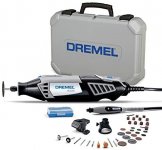
Eucy
I mentioned extended hf ...It does that but most importantly in my testing with solid timber and plywood panels it increases vocal clarity, noticeably brings vocals to the front of the panel and cuts out the often slightly muted sound caused by the panel thickness.
You'll need this (or equal):

Eucy
Yes I will probably test it.Hi Christian
Ok . You can be a tester for the carbonate..👍. Steve indicated it has a glassy sound
The problem with the Loctite primer is that it's expensive and a small bottle
Not at all meant for large area prep.
Probably a better bet would be plastic primer spray sold for vehicles
Sand the panel, spray the primer and finish with a suitable (to be determined) light top coat. It may still be a bit prone to scratching off if not carefully handled.
Eucy
For the glue, what I have is LOCTITE SUPERGLUE ALL PLASTICS . Available in almost all the stores. Its ok for small surfaces like the voice coil interface. The missing step is how to design a solution for testing.
In a previous post, I think you mention the use of aluminum. Have you tested that?
A blast from the past I found online:
https://worldradiohistory.com/Archive-Catalogs/Lafayette-Catalogs/Lafayette-1969-690.pdf
check out page 95 or search for planar
Eucy
https://worldradiohistory.com/Archive-Catalogs/Lafayette-Catalogs/Lafayette-1969-690.pdf
check out page 95 or search for planar
Eucy
This article has some interesting details/views on dome tweeters:
https://www.thebroadcastbridge.com/content/entry/9407/loudspeaker-technology-part-10-tweeters
EucyDome Episode 3:
You will need these (or equal):
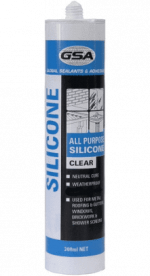
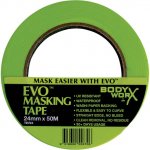
Eucy
https://www.thebroadcastbridge.com/content/entry/9407/loudspeaker-technology-part-10-tweeters
EucyDome Episode 3:
You will need these (or equal):


Eucy
Hi ChristianYes I will probably test it.
For the glue, what I have is LOCTITE SUPERGLUE ALL PLASTICS . Available in almost all the stores. Its ok for small surfaces like the voice coil interface. The missing step is how to design a solution for testing.
In a previous post, I think you mention the use of aluminum. Have you tested that?
Not yet but it's related somewhat to the dome series .......
Hello ChristianYes I will probably test it.
For the glue, what I have is LOCTITE SUPERGLUE ALL PLASTICS . Available in almost all the stores. Its ok for small surfaces like the voice coil interface. The missing step is how to design a solution for testing.
In a previous post, I think you mention the use of aluminum. Have you tested that?
While Tech Ingredients tested a aluminum panel and complained about ringing I've wondered about a aluminum sandwich panel. Here's a link to an art panel 4mm thick with a polyethylene core. Any thoughts ?
https://www.jerrysartarama.com/alumacomp-archival-aluminum-painting-and-mounting-panels
Pete
As fate decrees, I happen to have a smallish sample of such a panel - not 4mm thick but about 2-2.5mm ish - used for caravan panels it seems - not sure - was given to me by a friend who obtained some from a caravan builders junk pile - thought I'd try and test it some time - it rings a bit om a tap test and it's relatively heavy so not sure - will take some oof to drive it I reckonHello Christian
While Tech Ingredients tested a aluminum panel and complained about ringing I've wondered about a aluminum sandwich panel. Here's a link to an art panel 4mm thick with a polyethylene core. Any thoughts ?
https://www.jerrysartarama.com/alumacomp-archival-aluminum-painting-and-mounting-panels
Pete
Eucy
- Home
- Loudspeakers
- Full Range
- A Study of DMLs as a Full Range Speaker
